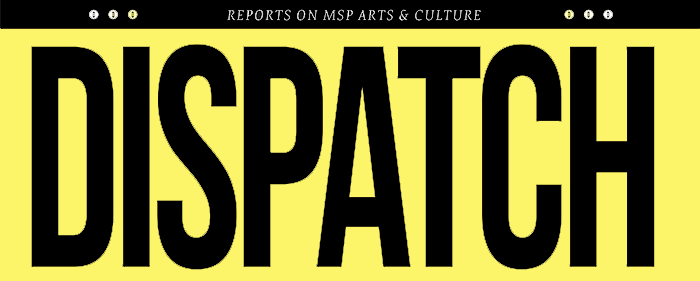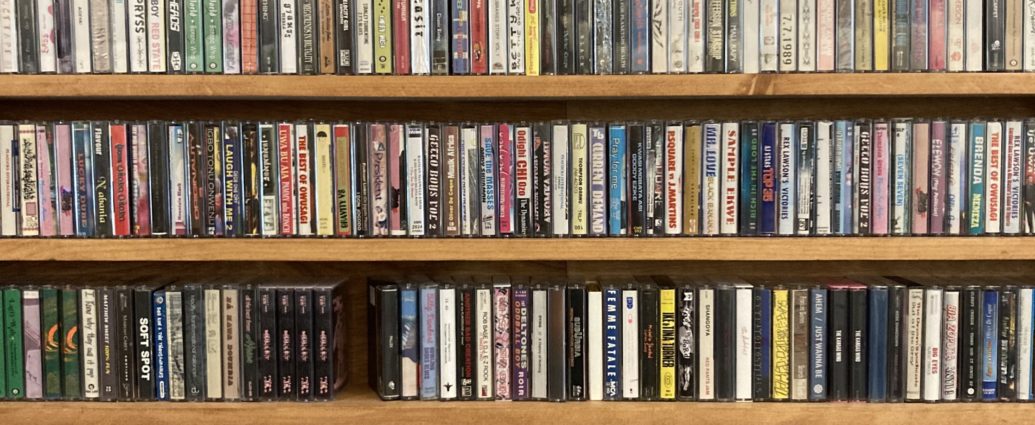The next chapter in the hiss-tory of mixing tapes includes many Twin Cities record stores, vintage stores, and home stereos.
WORDS BY TAYLOR CARIK
German rockers Scorpions released Love At First Sting in March of 1984, Madonna’s True Blue came out June of 1986, Janet Jackson went into seclusion at Flyte Tyme Studio in Edina in 1988 to deliver the landmark Janet Jackson’s Rhythm Nation 1814 in 1989.
Hitting the fast-forward button: Pop punk It Girl Monica LaPlante released the breakthrough Noir in 2016. Minneapolis-St. Paul Doom Metalers Nightosaur released their triumphant EP Future Songs in 2017. Fearsome Twin Cities twosome Warcake released the punishing full-length Puce in 2021.
Despite 30-plus years age difference, they’re all presently in rotation on the cassette deck in my garage, my new favorite place to listen to music.
With the resurgence of vinyl, much has been made about the experience of recorded music, how it’s purchased, how it’s opened, how it’s played, how it’s collected, how it’s displayed, who’s buying it.
On a much smaller scale, cassettes have tapped into the same rejection of streaming’s limitless abundance, but have also included the important elements of affordability and availability for music producers and purchasers that vinyl’s comeback doesn’t offer.
First, the elephants in the vinyl room: If you weren’t aware, at the start of wax’s big comeback, Urban Outfitters claimed to be the biggest seller of vinyl in the U.S.; it’s now actually Amazon. In this business mix, powerhouses like—you could guess it— Taylor Swift have commandeered nearly all of the major vinyl presses in the country. Metallica even announced this year they’re building their own vinyl press so they don’t get caught in the production line behind Swift.
(Speaking to the appeal of vinyl today, I recently bought my son his first vinyl album, Master of Puppets. Thank you, Stranger Things, for re-popularizing the song so much that kids in elementary school thought it cut from a cool streaming show, not dad metal. He very seriously asked me if I ever heard the song. I looked around to see if I was being pranked.)
Unlike the bottom-bin, scuffed-up $1 albums peppered throughout record stores, these new top-shelf premium album commodities can run $18-$48 in some cases. This popularity and pricing helped this year’s Record Store Day break records (always intend your puns, cowards) and continue the trend of newer generations getting into the grooves.
But what about the starving artists and underfunded art appreciators? Unable to generate enough gig- or Kickstarter-cash to pay for limited vinyl production runs—if there’s even an available location to produce said vinyl—both are rediscovering that cassettes possess all the tactile fun as records do.
As the sign above the wall-rack of tapes at Roadrunner Records says: “CASSETTE TAPES ALL THE RAGE.” Record stores and vintage shops all over Minneapolis-St.Paul are expanding, curating, and localizing their cassette selections, thanks to the resurgence in interest and Twin Cities’ bands output.
Disco Death captures the zeitgeist, thanks to being at it for a few years. Joel Eckerson and Colin Wilkinson helped launch Disco Death from the ashes of the former Dead Media space. The previous location stocked several different tapes, but unlike several other locations, its new wall of tapes focuses more on hard-to-find and interesting albums—but it’s not to break fans’ banking accounts.
“Most of our [cassettes] are priced around $3, we want people to be able to discover something and just buy it.” The inventory, even though full of collectibles from punk and metal bands or bands that no longer exist or even African bands, is priced lower than what the shops would compare on Discogs music-collecting site.
“Are these for your car?” asked a record store clerk at a different trip on a recent trip to grab a few classic cassettes. (Up until a year or two ago, yes, they could’ve been. Arts & Culture coverage and cars so old they have low-quality stereos go hand in hand.)
Another added bit of entertainment from the increasing discussions of the tape trend worth mentioning: The cassette resurgence makes some mid-career musicians and music fans show their temperamental sides. More than once, while discussing the return of the format, I’ve heard pushback on sound quality, or even the ability to play them. “What do you even do with these?” “Can you even play them?” “Why should we have to go back to adding deck components to our stereos ?” have all remained popular refrains, even for some vinyl collectors.
The artistic commodity and sound quality are, of course, the point.
Musicians lucky enough to put out some recorded music go through the five stages of grief: Writing, Recording, Mixing, Mastering, Artwork. The most impenetrable of the list is often the mastering—it’s why so many albums these days get famously “remastered” for new editions. Along with dictating the overall character of a collection of songs, mastering also reflects the artist’s preferred delivery method. It’s why remasters these days lean into mastering for puffy bluetooth headphones on one end of the spectrum or 180-gram vinyl on the other.
Love At First Sting, True Blue, Janet Jackson’s Rhythm Nation 1814—these albums hit between 1984-1991, the era between vinyl albums and what some classify as the unfortunate misstep of the compact disc (CDs). Knowing kids would be popping them in their boomboxes and Walkman’s (famously discontinued in 2010; now concurrently making a resurgence), playing them in their rooms and backyards, making their High Fidelity mixed tapes odes, and twisting a pencil in case of emergency, the albums had a specific sound for these locations.
Until I heard Scorpions’s ‘Bad Boys Running Wild’ blasting off the walls of my garage from the old cassette playing on my tape deck acquired from a garage sale, mastering and remastering didn’t really click for me. A million times I’ve streamed a crisp digital version of the track through various speakers over the years, but hearing Rudolf Schenker’s shredding guitar and Klaus Meine’s squealing vox cutting through the full sonic layer of the band on cassette—that’s how a listener and enthusiast can easily understand the intended proper character of the Scorp’s sound.
Musically it also can’t be a coincidence that bands with throwback sounds like Japanese Breakfast and MUNA are coming at a time when cassettes have hit the sweet spot between nostalgia, artistry, and availability that will likely continue their appeal for new younger listeners and bringing back the less staunch older audiences—if you can just find a player.
WHERE TO GET (BACK INTO) CASSETTES
Looking to start your own cassette selection, maybe make a few mixtapes of your own? Tape a look at these locations:
Disco Death Records
721 W 26th St, Mpls
discodeathrecords.com
One of the best curated selections of cassettes—of anything, really—the coffee shop record store’s tape wall is a must-visit for fans of music in any format.
Time Bomb Vintage
3543 E Lake St, Mpls
timebombvintage.com
Tape hunters in the know scan through the selection at the front of the store before making their way to the fuller back racks next to the vinyl.
Cheapo Records
2600 Nicollet Ave, Mpls, MN
cheapodiscs.com
What’s better than scouring the wall racks? Pulling the boxes at Cheapo. Lots of albums from the peak cassette time, but less available albums surface, including hip-hop ones.
Caydence Records & Coffee
900 Payne Ave, St Paul
caydencemn.com
Like their vinyl stock, Caydence doesn’t boast the biggest inventory, but the cafe/store/venue similarly has a thoughtful selection of cassettes that hit a lot of highlights from the peak cassette era along with some earlier releases.
Roadrunner Records
4534 Nicollet Ave, Mpls
roadrunnermpls.com
Although condensed—similar to their vinyl offerings—Roadrunner Records features one of the best selections of classic album cassettes in the Twin Cities.

